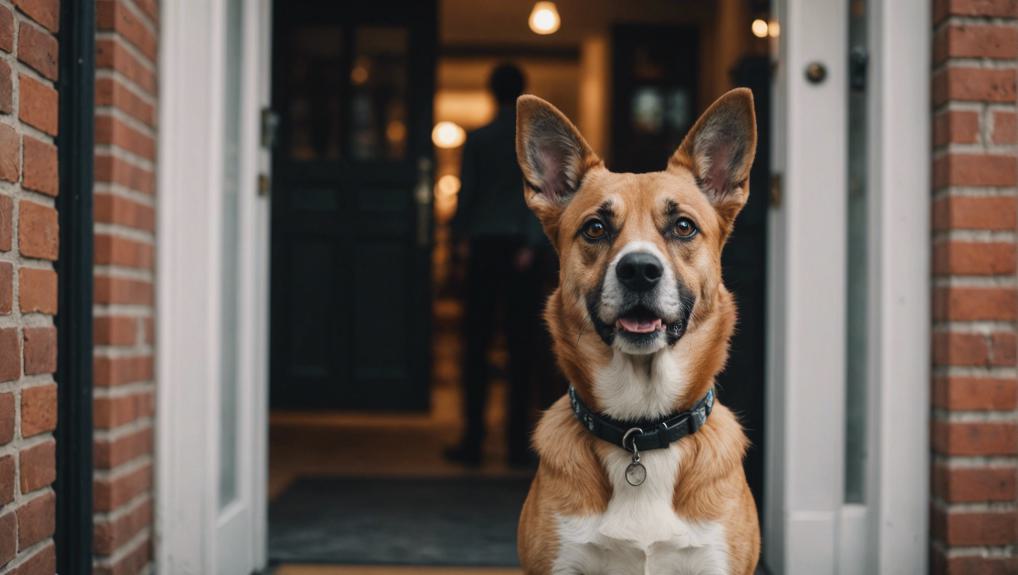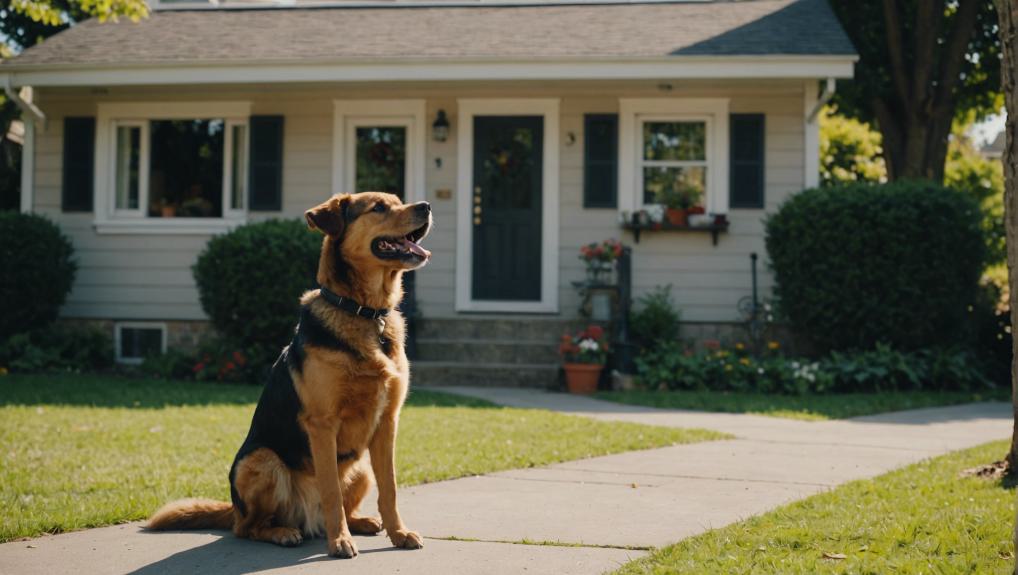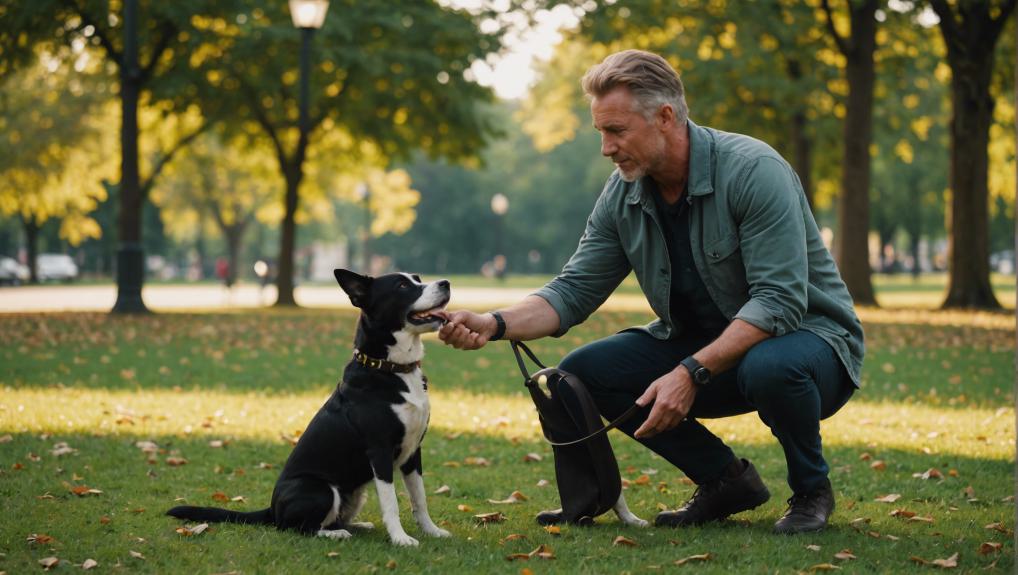How to Train a Dog to Bark at Strangers? Insider Tips!
To train your dog to bark at strangers effectively, start by grasping their protective instincts and body language cues. Adapt your training to fit your dog’s breed tendencies and use positive reinforcement for desired behavior. Establish alert areas and specific commands while rewarding good behavior consistently. Foster trust and confidence through training to encourage barking. Utilize family members to differentiate between known and unknown individuals. Seek professional guidance if needed, and address any behavioral issues promptly. Maintain a regular training schedule with timely reinforcement techniques. Celebrate each milestone in your dog’s progress to keep them motivated and confident. Additional insights await for a well-rounded training approach.
Understanding Dog Behavior
When training a dog to bark at strangers, grasping their natural instincts is crucial. Dogs bark at strangers as a protective and territorial instinct, signaling potential threats.
To train your dog to bark at strangers effectively, comprehending their body language and vocal cues is essential. Different breeds may have varying tendencies in terms of barking at strangers, so tailor your training approach accordingly.
Consistent training sessions help reinforce the desired behavior of alerting you to unfamiliar individuals. By observing how your dog reacts to strangers and providing positive reinforcement during training, you can encourage them to bark when necessary.
Establishing Clear Boundaries
To guarantee effective training in getting your dog to bark at strangers, establishing clear boundaries is essential. Boundaries help your dog understand when it’s appropriate to bark at unfamiliar faces, creating a sense of security within your home. Consistent training reinforces these boundaries, preventing confusion in your dog’s response to strangers. By setting clear limits, you provide a framework for your dog to follow, ensuring a more controlled and focused training experience. Here’s a table to guide you through the process of establishing boundaries:
| Training Step | Description |
|---|---|
| Define the area | Determine where your dog should alert you |
| Use consistent cues | Establish specific commands for barking at strangers |
| Reward good behavior | Reinforce boundary training with positive feedback |
| Practice regularly | Regular training sessions help solidify boundaries |
Follow these steps to set the foundation for successful stranger alert training.
Building Trust and Confidence

Building a strong bond with your dog is essential for fostering trust and confidence during the training process to bark at strangers.
Training your dog to bark at strangers requires a foundation of trust and confidence in their abilities. Confidence in your dog’s capabilities will help them react appropriately in situations where barking is necessary.
Consistent positive reinforcement plays a key role in building trust and confidence between you and your furry companion. By creating a safe and supportive environment, you encourage your dog to bark when needed without hesitation.
Through training, you develop a strong bond that enhances communication and obedience, making the process smoother and more effective. Remember, a trusting and confident dog is more likely to respond positively to your training efforts.
Using Positive Reinforcement Techniques
Wondering how you can effectively utilize positive reinforcement techniques when training your dog to bark at strangers?
Training your dog to bark at strangers using positive reinforcement involves rewarding them with treats or praise when they exhibit the desired behavior. It’s beneficial to use a specific cue word like ‘speak’ to associate with barking, helping your dog understand the action you’re looking for. Avoid punitive methods as they can create fear and anxiety in your furry friend.
Practice consistently in controlled environments to reinforce the behavior of barking at strangers. Gradually expose your dog to strangers while continuing to reinforce positive behavior to guarantee successful training. Remember, patience and persistence are key when using positive reinforcement techniques in teaching your dog to bark at strangers.
Consistency in Training Sessions

When training your dog to bark at strangers using positive reinforcement techniques, maintaining consistency in your training sessions is key to reinforcing the desired behavior effectively. Here are some tips to help you stay on track:
- Set a regular and structured training schedule to help your dog understand and respond to the command consistently.
- Repetition is essential; repeating training sessions will build a strong association between the command and the desired behavior.
- Dogs thrive on routine, so consistent training sessions are more effective in shaping their behavior.
- By sticking to a consistent schedule, you can guarantee steady progress in teaching your dog to bark at strangers.
Involving Family Members in Training
Incorporate your family members into the training sessions to enhance your dog’s ability to differentiate between known individuals and strangers effectively. Utilize their presence to help your dog practice barking commands in a familiar setting.
By involving family members, your dog can better distinguish between friendly faces and potential threats during training. This practice creates a supportive environment for your dog, ensuring consistency in their responses to various people.
With family members participating, your dog learns to react appropriately to different individuals, strengthening their ability to bark at strangers when necessary. Training with your family not only aids in teaching your dog to bark at strangers but also fosters a sense of security and confidence in your pet’s responses.
Seeking Professional Guidance When Needed

Expert guidance from experienced trainers can greatly enhance your dog’s training to bark at strangers. If you feel overwhelmed or uncertain about how to proceed, seeking professional help is a wise choice.
Here’s why you should consider it:
- Tailored Solutions: Professional help guarantees customized training plans for your dog’s specific needs.
- Behaviorists: These specialists excel in addressing complex behavioral issues, such as barking at strangers.
- Obedience Classes: Enrolling your dog in these classes can aid in socialization and improving responses to strangers.
- Training Aids: Tools like clickers can assist in reinforcing desired behaviors during training sessions.
Addressing Complex Behavioral Issues
If your dog displays aggression towards strangers, addressing the root causes of this behavior is vital to fostering a positive and safe environment for both your pet and others. Behavioral issues in dogs, such as aggression, can stem from fear, anxiety, or past experiences.
Seeking professional help from a certified behaviorist or trainer is essential when dealing with complex behavioral issues. These experts can guide you in implementing desensitization and counterconditioning techniques to modify aggressive behavior towards strangers.
Consistent training, patience, and empathy are key elements in addressing these issues effectively. By working with professionals and using specialized techniques, you can help your dog overcome aggression towards strangers and create a harmonious relationship built on trust and positive interactions.
Maintaining a Regular Training Schedule

To effectively train your dog to bark at strangers, it’s essential to establish a consistent training routine. By sticking to regular sessions, you reinforce the desired behavior and create a structured environment for learning.
Timely reinforcement techniques during these sessions help solidify the training and keep your dog engaged.
Consistent Training Routines
Establishing a consistent training routine for your dog requires dedication and regularity in your daily sessions. To maintain a structured approach and guarantee progress, follow these tips:
- Set aside dedicated time daily for training sessions: Consistency is key in reinforcing desired behaviors.
- Keep training sessions short and engaging: This helps maintain your dog’s focus and enthusiasm.
- Involve all family members in training: A unified approach guarantees everyone is on the same page.
- Monitor progress and adjust techniques: Tracking your dog’s development allows you to adapt your training methods for maximum effectiveness.
Timely Reinforcement Techniques
Maintaining a regular training schedule for your dog involves timely reinforcement techniques to solidify their response to strangers. Consistent training sessions, lasting 10-15 minutes daily, are vital for reinforcing the association between barking and strangers’ presence. Timely reinforcement through treats and praise immediately after the correct barking behavior is essential. By sticking to a consistent training schedule, you help your dog solidify its response to strangers over time. Monitoring your dog’s progress and adjusting training techniques as needed guarantees effective outcomes. Here is a table summarizing the key points:
| Key Points | Details | Importance |
|---|---|---|
| Consistent Timing | 10-15 min daily sessions | Reinforcement |
| Timely Rewards | Treats and praise post-correct barking | Motivation |
| Monitoring Progress | Track and adjust techniques | Effectiveness |
Celebrating Training Milestones
When training your dog to bark at strangers,
it’s important to acknowledge and reward each step forward.
By celebrating milestones with treats and consistent training,
you reinforce the desired behavior.
Tracking behavior changes helps you monitor progress
and keep your dog motivated throughout the training process.
Rewarding Progress With Treats
To reinforce positive behavior effectively, promptly reward your dog with high-value treats immediately after successfully barking at a stranger. Here are some tips to help you reward progress with treats:
- Use high-value treats that your dog loves to make the reward more enticing.
- Gradually reduce the frequency of treat rewards as your dog becomes more consistent in barking at strangers.
- Celebrate training milestones by offering special treats or extra praise to acknowledge progress.
- Consistency in rewarding with treats is essential to maintain the desired behavior of barking at strangers.
Consistent Training Sessions
Celebrate your dog’s progress by acknowledging small training milestones, like successfully responding to the ‘speak’ command. Each time your furry friend barks at a stranger upon command, it’s a step towards mastering the desired behavior.
Keep the training sessions consistent to reinforce this behavior. Use positive reinforcement techniques such as treats and praise to reward your dog for barking at strangers. By maintaining a structured training schedule, you help your dog understand what’s expected of them.
Remember to keep track of your dog’s progress by noting how often and accurately they bark at strangers. Utilize a training journal to record successful sessions and areas that need improvement, ensuring a holistic approach to your dog’s training journey.
Tracking Behavior Changes
You can track your dog’s behavior changes by acknowledging milestones in their training progress, particularly when they bark at strangers. Here are some tips to help you monitor your dog’s progress effectively:
- Celebrate each time your dog barks at strangers as a milestone in their training journey.
- Monitor changes in behavior to track improvements in barking at unfamiliar individuals.
- Note any positive responses or increased alertness towards strangers during training sessions.
- Document instances where your dog successfully identifies and barks at unknown individuals.
Frequently Asked Questions
How Do I Teach My Dog to Bark at Strangers?
To teach your dog to bark at strangers, use a specific command like ‘speak’ and reward them when they bark at unfamiliar people. Consistently reinforce the command in various scenarios to establish comprehension. Encourage barking for security and alertness.
How Do I Teach My Dog to Bark at Intruders?
To teach your dog to bark at intruders, train them to ‘speak’ on command using positive reinforcement. Introduce a cue word for strangers. Practice consistently in different scenarios for reliable responses. Treats and praise help reinforce the behavior effectively.
Why Won T My Dog Bark at Strangers?
Your dog may not bark at strangers due to fear, lack of socialization, medical issues, breed tendencies, or past negative experiences. To encourage barking, address underlying causes, reward desired behavior, and consider professional training if needed.
How Do You Train a Dog to Bark Aggressively?
To train your dog to bark aggressively, use a specific cue word like ‘speak,’ reward the behavior with treats, and practice in controlled settings. Avoid promoting excessive aggression, focus on targeted barking, and consult a professional trainer if needed.
Conclusion
To sum up, teaching your dog to bark at strangers requires patience, consistency, and positive reinforcement.
By grasping your dog’s behavior, setting clear boundaries, and building trust, you can help your furry friend become a reliable watchdog.
Celebrate each milestone in your training journey and seek professional guidance if needed.
With a regular training schedule and dedication, your dog will learn to bark at strangers in a safe and controlled manner.
Keep up the great work!

